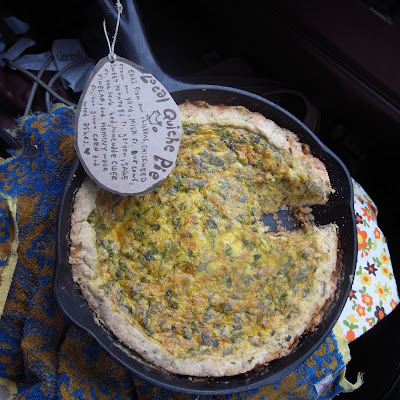skip to main |
skip to sidebar
Friends!Springtime springtime springtime! Everything is looking exceptionally beautiful, and the baby plants are doing well. Here comes the cabbage. We turned some old windows and untreated lumber into cold frames. Miniature passive-solar houses for the greens! Spinach, Red Russian Kale, Asian Greens mix, Chard.
Everything is looking exceptionally beautiful, and the baby plants are doing well. Here comes the cabbage. We turned some old windows and untreated lumber into cold frames. Miniature passive-solar houses for the greens! Spinach, Red Russian Kale, Asian Greens mix, Chard. Our super-local Farm Quiche won first prize in a pie contest! All but the flour, salt, and pepper were ingredients gleaned from farm life. Try it, friends.
Our super-local Farm Quiche won first prize in a pie contest! All but the flour, salt, and pepper were ingredients gleaned from farm life. Try it, friends. Crust: flour, sage, salt, butter, some milk, cider vinegarFill: 3 eggs, milk, chickweed, shredded sweet potatoes, bloody butcher corn turned hominy, salt + pepperThis happens in an iron skillet. 350. Bake till filling rises. About 45 minutes.Oh yes, and Sprouts! Fenugreek, chickpeas, wheat berries, other beans or grains. Put them in a jar with something breath-able on top (wire mesh with lid, cheesecloth, etc.). Fill only about 1/8. Cover with water overnight. Rinse and drain upside down. Rinse and drain again! Again! Again! Every day! You've got sprouts come few days. That's for you Jen C. (I'll get a photo!).Happy warm days ahead.
Crust: flour, sage, salt, butter, some milk, cider vinegarFill: 3 eggs, milk, chickweed, shredded sweet potatoes, bloody butcher corn turned hominy, salt + pepperThis happens in an iron skillet. 350. Bake till filling rises. About 45 minutes.Oh yes, and Sprouts! Fenugreek, chickpeas, wheat berries, other beans or grains. Put them in a jar with something breath-able on top (wire mesh with lid, cheesecloth, etc.). Fill only about 1/8. Cover with water overnight. Rinse and drain upside down. Rinse and drain again! Again! Again! Every day! You've got sprouts come few days. That's for you Jen C. (I'll get a photo!).Happy warm days ahead.

Little Zoe is part of the herd now! Kind of.
 We've been fermenting various foods lately in our new collection of crocks, two company-made in Zanesville, OH, and the nicest of the set hand-thrown by our friend Jordan and coated in a homemade glaze made using wood ash from his woodstove. Our pickling experiments have included sauerkraut, beets, turnips, rutabagas, and now crock dill pickles!
We've been fermenting various foods lately in our new collection of crocks, two company-made in Zanesville, OH, and the nicest of the set hand-thrown by our friend Jordan and coated in a homemade glaze made using wood ash from his woodstove. Our pickling experiments have included sauerkraut, beets, turnips, rutabagas, and now crock dill pickles!

So, since we still like our tree-based sugars, we decided to try out tapping what we do have. We started with two Tulip Poplars, plenty big for at least one tap each. I made the spouts from sumac branches since they are naturally hollow in the center once you remove the pith, a spongy orange foamy substance. They were carved to have a taper, so they would hold into the tree, and then were pounded gently into holes we drilled with a brace and bit. We then hung old (washed!) milk jugs on the spouts, and now we get to wait.

The next step, should we successfully get some sap from these trees, is to boil down the sap into syrup or sugar. It's no small process, as even with the high sugar content of maple trees it takes around 40 gallons of sap to yield one gallon of syrup! Our yields will probably be even less...but we'll see!












